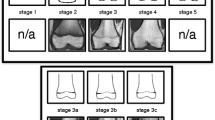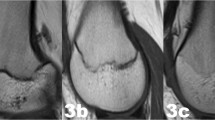Abstract
The establishment of radiation-free examination procedures in the field of forensic age diagnostics in living persons is to be considered of special scientific interest so as to minimize necessary exposure to X-rays while facilitating additional assessment of skeletal development in all cases. To this end, the advantages offered by magnetic resonance imaging in securing a practical application which is as unrestricted and complication-free as possible should be among the methods exploited in investigating such indicators of skeletal maturity. Within the framework of a retrospective study, we investigated the ossification status of the proximal tibial epiphysis on the MRI scans of 124 females and 166 males aged between 10 and 30 years. All the images had been generated on a 3.0 T scanner using a T1-weighted turbo spin-echo sequence. When evaluating the ossification stage, a combination of modified classifications proposed by Schmeling et al. and by Kellinghaus et al. was used. The statistical evaluation included calculation of a variety of measures to describe specific ossification stages as well as kappa coefficients to assess intra- and inter-observer agreement on diagnoses of individual stages. In forensic contexts, completion of the 14th year of life can be adequately evidenced in females with an ossification stage IV according to Schmeling et al. and in males with an ossification stage III c according to Kellinghaus et al. or an ossification stage IV according to Schmeling et al. In forensic contexts, the presence of an ossification stage IV according to Schmeling et al. can prove that the age of 16 years has been exceeded only in the male sex, whereby for age estimation purposes the diagnosis should be in line with other skeletal maturity indicators. The results available displayed a high degree of intra- and inter-observer agreement. Examination of the ossification status of the proximal tibial epiphysis using magnetic resonance imaging represents an effective additional tool for use in radiation-free forensic age diagnostics in living persons.






Similar content being viewed by others
References
Lockemann U, Fuhrmann A, Püschel K, Schmeling A, Geserick G. Arbeitsgemeinschaft für Forensische Altersdiagnostik der Deutschen Gesellschaft für Rechtsmedizin: Empfehlungen für die Altersdiagnostik bei Jugendlichen und jungen Erwachsenen außerhalb des Strafverfahrens. Rechtsmedizin. 2004;14:123–5.
Schmeling A, Grundmann C, Fuhrmann A, Kaatsch HJ, Knell B, Ramsthaler F, Reisinger W, Riepert T, Ritz-Timme S, Rösing FW, Rötzscher K, Geserick G. Criteria for age estimation in living individuals. Int J Legal Med. 2008;122:457–60.
Kellinghaus M, Schulz R, Vieth V, Schmidt S, Pfeiffer H, Schmeling A. Enhanced possibilities to make statements on the ossification status of the medial clavicular epiphysis using an amplified staging scheme in evaluating thin-slice CT scans. Int J Legal Med. 2010;124:321–5.
Kellinghaus M, Schulz R, Vieth V, Schmidt S, Schmeling A. Forensic age estimation in living subjects based on the ossification status of the medial clavicular epiphysis as revealed by thin-slice multidetector computed tomography. Int J Legal Med. 2010;124:149–54.
Parzeller M. Rechtliche Aspekte der forensischen Altersdiagnostik. Rechtsmedizin. 2010;21:12–21.
Bilgili Y, Hizel S, Kara SA, Sanli C, Erdal HH, Altinok D. Accuracy of skeletal age assessment in children from birth to 6 years of age with the ultrasonographic version of the Greulich-Pyle atlas. J Ultrasound Med. 2003;22:683–90.
Quirmbach F, Ramsthaler F, Verhoff MA. Evaluation of the ossification of the medial clavicular epiphysis with a digital ultrasonic system to determine the age threshold of 21 years. Int J Legal Med. 2009;123:241–5.
Schmidt S, Schmeling A, Zwiesigk P, Pfeiffer H, Schulz R. Sonographic evaluation of apophyseal ossification of the iliac crest in forensic age diagnostics in living individuals. Int J Legal Med. 2011;125:271–6.
Schmidt S, Schmeling A, Zwiesigk P, Schiborr M, Pfeiffer H, Schulz R. Ultrasound studies on age dependency of epiphyseal ossification of the distal radius. Scand J Forensic Sci. 2011;17:17–20.
Schmidt S, Schiborr M, Pfeiffer H, Schmeling A, Schulz R. Age dependence of epiphyseal ossification of the distal radius in ultrasound diagnostics. Int J Legal Med. 2013;127:831–8.
Schmidt S, Schiborr M, Pfeiffer H, Schmeling A, Schulz R. Sonographic examination of the apophysis of the iliac crest for forensic age estimation in living persons. Sci Justice. 2013;53:395–401.
Schulz R, Zwiesigk P, Schiborr M, Schmidt S, Schmeling A. Ultrasound studies on the time course of clavicular ossification. Int J Legal Med. 2008;122:163–7.
Schulz R, Schiborr M, Pfeiffer H, Schmidt S, Schmeling A. Sonographic assessment of the ossification of the medial clavicular epiphysis in 616 individuals. Forensic Sci Med Pathol. 2013;9:351–7.
Schulz R, Schiborr M, Pfeiffer H, Schmidt S. Schmeling. A Sonographic examination on the time frame of ossification of the distal fibula epiphysis. Arch Kriminol. 2013;231:156–65.
Dvorak J, George J, Junge A, Hodler J. Age determination by magnetic resonance imaging of the wrist in adolescent male football players. Br J Sports Med. 2007;41:45–52.
Dvorak J, George J, Junge A, Hodler J. Application of MRI of the wrist for age determination in international U-17 soccer competitions. Br J Sports Med. 2007;41:497–500.
Dvorak J. Detecting over-age players using wrist MRI: science partnering with sport to ensure fair play. Br J Sports Med. 2009;43:884–5.
Brossmann J, Stäbler A, Preidler KW, Trudell D, Resnick D. Sternoclavicular joint: MR imaging–anatomic correlation. Radiology. 1996;198:193–8.
Hillewig E, Degroote J, Van der Paelt T, Visscher A, Vandemaele P, Lutin B, D’Hooghe L, Vandriessche V, Piette M, Verstraete K. Magnetic resonance imaging of the sternal extremity of the clavicle in forensic age estimation: towards more sound age estimates. Int J Legal Med. 2013;127:677–89.
Schmidt S, Mühler M, Schmeling A, Reisinger W, Schulz R. Magnetic resonance imaging of the clavicular ossification. Int J Legal Med. 2007;121:321–4.
Craig JG, Cody DD, Van Holsbeeck M. The distal femoral and proximal tibial growth plates: MR imaging, three-dimensional modelling and estimation of area and volume. Skeletal Radiol. 2004;33:337–44.
Dedouit F, Auriol J, Rousseau H, Rougé D, Crubézy E, Telmon N. Age assessment by magnetic resonance imaging of the knee: a preliminary study. Forensic Sci Int. 2012;217:232.e1-7.
Jopp E, Schröder I, Maas R, Adam G, Püschel K. Proximale Tibiaepiphyse im Magnetresonanztomogramm. Neue Möglichkeit zur Altersbestimmung bei Lebenden? Rechtsmedizin. 2010;20:464–8.
Laor T, Chun GF, Dardzinski BJ, Bean JA, Witte DP. Posterior distal femoral and proximal metaphyseal stripes at MR imaging in children and young adults. Radiology. 2002;224:669–74.
Schmeling A, Schulz R, Reisinger W, Mühler M, Wernecke K-D, Geserick G. Studies on the time frame for ossification of medial clavicular epiphyseal cartilage in conventional radiography. Int J Legal Med. 2004;118:5–8.
Cardoso HF. Epiphyseal union at the innominate and lower limb in a modern Portuguese skeletal sample, and age estimation in adolescent and young adult male and female skeletons. Am J Phys Anthropol. 2008;135:161–70.
Kuhns LR, Finnstrom O. New standards of ossification of the newborn. Radiology. 1976;119:655–60.
McKern TW, Steward TD. Skeletal age changes in young American males, analysed from the standpoint of age identification. Headquarters quartermaster research and development command, Technical report EP-45. Natick, MA; 1957.
O´Connor JE, Bogue C, Spence LD, Last J. A method to establish the relationship between chronological age and stage of union from radiographic assessment of epiphyseal fusion at the knee: an Irish population study. J Anat. 2008;212:198–209.
Pyle SI, Hoerr NL. Radiographic atlas of skeletal development of the knee. Springfield: C.C. Thomas; 1955.
Schaefer MC, Black SM. Comparison of ages of epiphyseal union in North American and Bosnian skeletal material. J Forensic Sci. 2005;50:777–84.
Scheuer L, Black SM. The juvenile skeleton. Amsterdam: Elsevier Academic Press; 2004.
Coqueugnit H, Weaver TD. Brief communication: infracranial maturation in the skeletal collection from Coimbra Portugal: new aging standards for epiphyseal union. Am J Phys Anthropol. 2007;134:424–37.
Dünkel F, Grzywa J, Horsfield P, Pruin I. Juvenile justice systems in Europe. Godesberg: Forum; 2010.
Author information
Authors and Affiliations
Corresponding author
Additional information
J. A. Krämer and S. Schmidt contributed equally to this work.
Rights and permissions
About this article
Cite this article
Krämer, J.A., Schmidt, S., Jürgens, KU. et al. The use of magnetic resonance imaging to examine ossification of the proximal tibial epiphysis for forensic age estimation in living individuals. Forensic Sci Med Pathol 10, 306–313 (2014). https://doi.org/10.1007/s12024-014-9559-2
Accepted:
Published:
Issue Date:
DOI: https://doi.org/10.1007/s12024-014-9559-2




